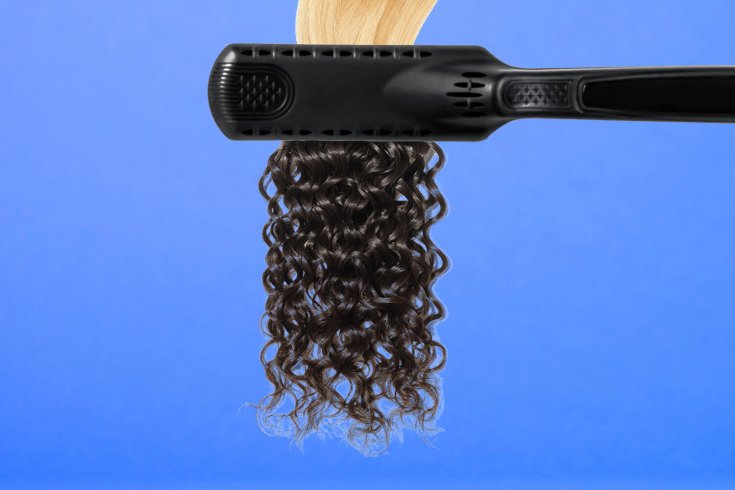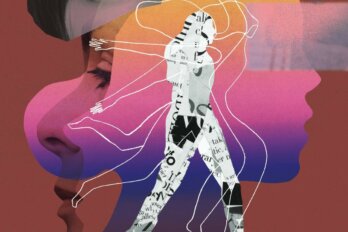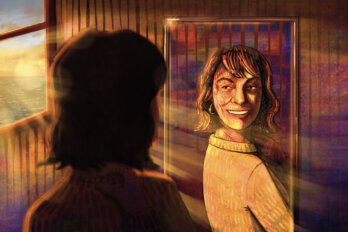“Beauty was not simply something to behold; it was something one could do.”
― Toni Morrison, The Bluest Eye
When I was fifteen years old, I remember going to one of the many hair salons inside what was then called the Metrotown Centre mall, located in Burnaby, British Columbia. I wanted somebody to fix my amateur, home-dyed, white-blond hair. I’ll never forget the way the stylist looked me up and down like she was assessing the situation, assessing the damage. She paused for a millisecond with her white hand on her hip before blurting out that they couldn’t “do my kind of hair” at this salon and that I might want to try something across the street. Before she even said which salon, I assumed she meant I should go to Abantu, a salon that specialized in braids, weaves, and fades—or, as the stylist put it, “the Black salon.”
I froze. Shouldn’t I be able to go to any salon I wanted? Why was she trying to make this choice for me? My reaction in that moment consisted of a blank stare, disappointment, and confusion. At first, I assumed she was reluctant to fix my homemade hair mistake because maybe it was unfixable. But that didn’t make sense. Her words cut deep. When she said, “My kind of hair,” it was the word kind that punched me in the stomach. My thoughts raced. I never heard of someone turning away a customer—a paying customer—for not having the right type of hair. I decided that I wasn’t going to take no for an answer.
Instead of going to the Black salon, as I was told to do, I went to the salon right across the mall. I looked back, and there she stood, with her hand still on her hip, while she watched me approach the counter of the other salon. Her eyes scorched the back of my white-blond hair. I felt this. The stylist from across the hallway (also white) sat me down, ran her fingers through my hair, and talked about adding lowlights to balance the look of the white. I watched her in the mirror as her fingers travelled from my soft white roots to the frayed ends of my hair. I watched her eyes. She smiled. She said, “We actually have a special on right now, and lowlights are half price.” I sat softer in the chair. I lessened my grip on the vinyl armrests. This salon, and the stylists, didn’t look any different than the first one. I didn’t mention my experience across the mall.
Today, I often think back to why I coloured my hair in the first place. Did I really have a choice? If you had asked me why, I might not have been able to put it into all the right words. I’m not sure I’d have been able to tell you what I know now: that I had ingested an insidious message over the course of my childhood and well into the first half of my teenage years. This message pounded inside my head constantly, like a bass line: blond is beautiful. There was no escaping it. On my way to school every day, I looked out the window as the bus zipped down Kingsway. My eyes would catch glimpses of billboards featuring blond, windblown hair, smiling faces, eyes that looked back at me. I swear, I physically felt the message insert itself in my brain and on the insides of my eyelids. I was powerless.
If I didn’t know it before, I knew it from the moment I left the salon that day: the way I chose to wear my hair would dictate the way people treated me. It would dictate their perception of who I was, what I had, and where I was going. I remember buying copies of magazines like Seventeen so that I could pore over the quizzes, latest jean trends, and makeup options. But the real reason I read those magazines was because I wanted to flip the page and see myself. I wanted to see my unruly hair sitting on the head of light-skinned brown woman. By the time I got to the horoscopes at the end of the magazine, I was always disappointed. “Well, maybe next month,” I would think to myself.
Absent of any other models, I saw my hair as confusing. My family constantly told me that I had “good” hair. According to them, I had the kind of hair that could easily be styled into anything I wanted. My family told me I should be happy with and proud of my hair. Society told me I should be blond. But, the moment I changed my hair, I was seen as not Black enough. I struggled with these mixed messages. Questions from others about my ethnicity seemed to be determined by how I wore my hair that day. I wanted to be seen, but I did not want to be questioned.
You have no control. We will embed in your brain. We will tell you what you need. These products will help you. Are you sure you want to walk around like that? Be real, come on. Maybe you want to stick out. Fine, that’s your choice. But you need to keep up, because if you fall behind it’s going to be quite the climb back up. Don’t worry about the money. Consider it an investment! Your hair is one thing, but you should also try some of our skin creams. How much sun do you get?
Twenty years after that day in the salon, I sat in a worn leather chair, immersed in complete calm. The needle pierced my skin, and the warmth was a welcome sensation. I know that many people would have been nervous at the thought of the needle moving in and out through the outer layer of their skin, over and over for hours. But, to me, it was ultrafreeing. A choice. A decision. I was part of a bigger process that I was designing for myself. Weeks earlier, on my thirty-fifth birthday, I had sat down with the tattoo artist. I had told him what I was looking for, how the shape and movement of the piece he was designing were so important. After all, this was no temporary change; this was something I would take with me everywhere I went. I watched his pencil as it glided over the page and he sketched out my future. The long sweeping grey of the graphite seemed to go on forever, extending beyond the white of the page.
When I was twenty-one, I got extensions for the first time. Braided extensions. When I first heard of interlocking, from one of my aunts who just had it done, I was thrilled. It only took a fraction of the time that individual braids took—four hours instead of ten. I purchased prebraided hair extensions to attach to my existing hair, which was first cornrowed. When I stepped out of that salon, I noticed I held my head a little higher. (Well, figuratively. I couldn’t hold it that high, since the added weight of the extensions sent my head tilting back. I had to relearn how to use the muscles in my neck). I was treated differently. No one asked me what I was or where I was from. Before the braided extensions, my ethnicity was questioned a lot. I would get a lot of comments like, “Are you sure you’re Black?” and, “Are you sure you’re not from Colombia?” I struggled with how to answer, because these questions hurt deep into my core, but I didn’t understand why. At the time, I didn’t recognize this questioning as microaggression the way I do now. I was questioned because I didn’t fit a template.
I wanted those questions to stop. When I realized I could eliminate doubt by appearing, through my hair choice, the way society wanted me to, that’s what I decided to do. For the next five years, I kept my hair this way (as long as I could afford to, anyway). I fell into the privilege of not having my ethnicity questioned. I wasn’t blond, but at least I fit someone’s template. But I couldn’t block out the whispers.
White. Blond. Long hair. Soft skin. Stay-out-the-sun skin. We will plaster this message all over magazines, movies, TV shows, billboards, and social media. There’s no escape. Give us your money, and we will make you beautiful. We guarantee they won’t be able to tell. They won’t see the transition line, and no one will ask you where you are from, because you will look Just. Like. Us.
I looked down at the swell of my freshly tattooed arm, and I did not look like anyone else. This is what I wanted. It was perfect. The lines, the movement, the deep greys, the rawness. It was me. I wanted to run my hand down my own freshly tattooed arm, but I couldn’t. It was too fresh. It needed to heal. It was mine and it was permanent.
Straightened hair might only last as long as it takes to complete: a few hours. When I was twenty-six, I straightened my hair for the first time. My boyfriend at the time told me how incredible it would look and that I should give it a try. Back to the salon I went, this time in Surrey, BC. An enthusiastic Turkish woman walked toward me in a half run, as if she instantly knew why I was there. She seemed keen to snag me as her project.
I remember her saying, “Come, sit,” motioning to her chair. “Ah yes. Beautiful curls, but you want it straight, right?”
“Yeah.”
“Okay, I’ll do this for you, no problem.”
Hours later, the silk that cascaded from my head was enough to put me into shock. I did not recognize the woman looking back at me in the mirror.
“Holy crap,” I said as I pulled my fingers through the smoothness. And like a familiar whisper, I heard those voices again: No one will ask you where you are from because you will look Just. Like. Us.
“You like?” I remember she asked me.
“Yeah, how long will it last?”
“Until you wash it.”
I lasted about five days before the itchiness of my scalp took over. I didn’t want to wash it. All that hard work, long hours in the chair, and money down the drain, literally. I looked in the mirror. Although the initial silkiness had disappeared, my hair was still sort of straight. I ran my fingers through it one last time, grabbed a towel, and dipped my head under the tap. Just as the water hit my scalp, the springiness of my curls jumped back into action, as if they have been waiting for this moment. The smoothness bidding me a fine farewell. I towelled off my hair and looked in the mirror again. My sopping curls—which should have been heavy from holding water—only made my head feel weightless.
The Beauty Conversation
Appearance shapes the way the world sees us. But what does it say about who we really are?
When I turned thirty-five, the same year I decided to get my first tattoo, I also decided that the four-dollar bottle of Dove curling mousse, which I now buy only on sale, was as much effort and money as I was willing to put into my hair. During the previous fifteen years, I had spent tens of thousands of dollars on my hair. Why? All those whispers I heard from billboards, magazines, and media took a toll on me. What really made me push away the idea of fitting a template was seeing and feeling how differently I looked at myself in the mirror after I chose to create something unique for myself via tattooing. The questions I get now are about my tattoos: What do they mean to you? Why the flowers? I’ve never seen shading like that before, where did you get that done? These are questions only I can answer. These are questions I want to answer.
I have my next three tattoos mapped out. All of them different and permanent, decided and designed by me. No two self-designed tattoos are the same. Just like writing—the best stories are those who could have only been written by one person. There’s an unspoken beauty in the power of drawing your own template. And there’s a sense of complete satisfaction deeply woven into the understanding that you are the only one who will ever fit it.





